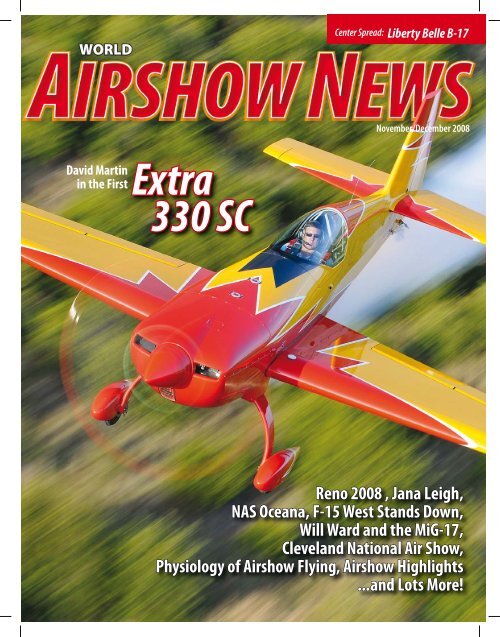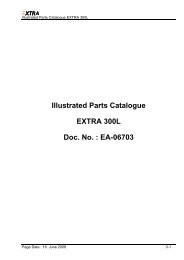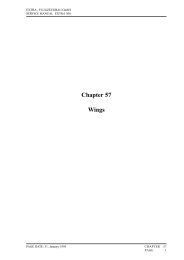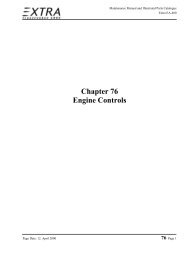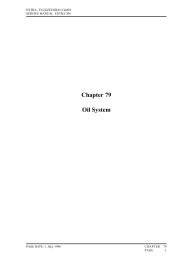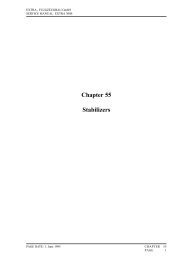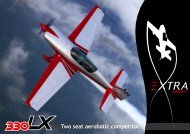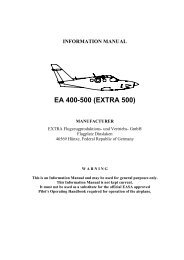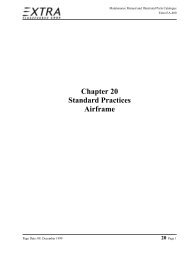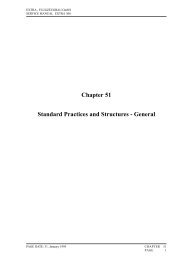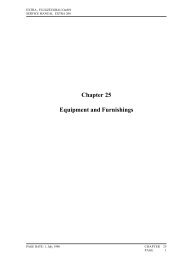Extra 330 SC - Extra Aircraft
Extra 330 SC - Extra Aircraft
Extra 330 SC - Extra Aircraft
- No tags were found...
Create successful ePaper yourself
Turn your PDF publications into a flip-book with our unique Google optimized e-Paper software.
Center Spread: Liberty Belle B-17<br />
November/December 2008<br />
David Martin<br />
in the First<br />
<strong>Extra</strong><br />
<strong>330</strong> <strong>SC</strong><br />
www.airshowmag.com<br />
Reno 2008 , Jana Leigh,<br />
NAS Oceana, F-15 West Stands Down,<br />
Will Ward and the MiG-17,<br />
Cleveland National Air Show,<br />
Physiology of Airshow Flying, Airshow Highlights<br />
...and Lots More!<br />
World Airshow News 1
UNLIMITED AEROBATIC competition is one of the most extreme<br />
sports known to man – aerial gymnastics performed by men and<br />
women flying 300 hp muscle-planes, played-out in a three-dimensional<br />
gymnasium in the sky.<br />
Not only must these elite pilots execute a sequence of challenging<br />
and complex aerobatic maneuvers requiring their bodies to endure<br />
up to plus or minus 10 times the force of gravity, they must do it<br />
while staying within a small cube of airspace. Most importantly, the<br />
maneuvers must be flown with great precision, with points deducted<br />
for even the slightest deviation from perfection.<br />
Such a demanding environment requires the utmost in piloting<br />
skill, dedicated and consistent practice and training, and the best aerobatic<br />
aircraft technology available. These pilots are constantly on the<br />
lookout for more capable aircraft, as even the<br />
slightest advance in performance can give them<br />
an edge on the competition. That little something<br />
extra can mean a World Championship.<br />
Walter <strong>Extra</strong> (photo by<br />
Jim Froneberger).<br />
By Jim Froneberger<br />
A World-Class Heritage<br />
After flying a modified Pitts Special in the<br />
1980 World Aerobatic Championships, awardwinning<br />
pilot Walter <strong>Extra</strong> wanted more. “I just<br />
wanted to take my competition flying to another<br />
level,” says <strong>Extra</strong>, a mechanical engineer. “So I<br />
went to work designing and building the first<br />
<strong>Extra</strong> 230.” In the process, <strong>Extra</strong> created a new<br />
company, <strong>Extra</strong> Flugzeugbau, to design and<br />
build his own line of aerobatic aircraft.<br />
The <strong>Extra</strong> 230 was completed in 1981 and<br />
featured a steel-tube fuselage, wooden wings,<br />
and a four-cylinder 230 hp engine swinging a<br />
two-blade prop. The success of this aircraft led<br />
him to build a more powerful version, the <strong>Extra</strong><br />
260, which featured a six-cylinder 260 hp engine and a three-blade<br />
prop. In the hands of Patty Wagstaff, the <strong>Extra</strong> 260 won multiple U.S.<br />
national aerobatic titles and is now in the Smithsonian Air and Space<br />
Museum in Washington, D.C.<br />
A two-seat, 300 hp version – the <strong>Extra</strong> 300 – followed in 1988. The<br />
<strong>Extra</strong> 300S, an improved single-seat 300 hp model, followed in 1992 and<br />
the two-seat version of the 300S – the 300L – was first flown in 1993.<br />
After its introduction in 1992, the <strong>Extra</strong> 300S became a mainstay<br />
in the unlimited aerobatic competition scene. At contests in 1994,<br />
1996, and 1998, as many as 25 <strong>Extra</strong>s competed. At the 1998 World<br />
Championships in Slovakia, the 300S made up the core of the U.S.<br />
team with Michael Goulian, Phil Knight, and David Martin all flying<br />
the type in competition.<br />
But that same year, the French Aerobatic Team won the team<br />
championship with Frenchman Patrick Paris being crowned World<br />
Champion. The French were flying the new CAP 232, and after both<br />
David Martin and Michael Goulian flew the 232, they both knew the<br />
choice of aircraft was a key element in the French win. “The 300S<br />
David Martin and the<br />
First <strong>Extra</strong> <strong>330</strong><strong>SC</strong><br />
A LITTLE SOMETHING EXTRA<br />
was still a very capable aircraft and you could win the World Contest<br />
in it, no doubt,” explained Martin. “But what we found out was that<br />
the CAP was easier. It didn’t necessarily perform better, but it was<br />
easier. In competition, easy is better because if it’s easier to fly, you’re<br />
less likely to make mistakes and more likely to win.”<br />
By the 2000 and 2001 world contests, the CAP 232 and Russian<br />
Sukhois were dominating the competition, and the number of <strong>Extra</strong><br />
300s entered had fallen to less than five. To stay competitive, even<br />
Goulian and Martin were soon flying the CAP 232 as well.<br />
As the CAPs and Sukhois emerged as the leaders in unlimited<br />
aerobatic competition, <strong>Extra</strong> refocused its energies on the two-seat<br />
<strong>Extra</strong> 300L and the newer lighter-weight, higher-performance <strong>Extra</strong><br />
300LP. During those years, the company also diversified, developing<br />
the <strong>Extra</strong> 400 and 500, both six-place, pressurized, single-engine<br />
2 World Airshow News November/December 2008
David Martin flies his new <strong>Extra</strong> <strong>330</strong><strong>SC</strong> near his home in Texas shortly after taking delivery. The Breitling decals had not even been applied yet (photo by Scott Slocum).<br />
pounds out of the 300S airframe and moving the center of gravity<br />
aft for increased maneuverability and decreased stability – desirable<br />
traits for an unlimited aircraft. To improve tumbling performance,<br />
the tail was also completely redesigned. The result was Goulian’s <strong>Extra</strong><br />
300SHP, which debuted at the Berlin Red Bull Air Race in May 2006<br />
and in the U.S. at EAA AirVenture in Oshkosh that summer.<br />
Goulian’s <strong>Extra</strong> 300SHP was never designed to be a production<br />
airplane. It was simply a one-of-a-kind concept airshow airplane.<br />
But the success of that airplane, coupled with Walter <strong>Extra</strong>’s desire<br />
to once again produce a world-class competitive aircraft, led to the<br />
decision to develop a new production airframe – the <strong>Extra</strong> <strong>330</strong><strong>SC</strong>.<br />
The tail, fuselage dimensions, and shape of the <strong>330</strong><strong>SC</strong> are esbusiness<br />
aircraft built with composite technology.<br />
<strong>Extra</strong> <strong>Aircraft</strong> became a U.S.–owned and operated company in<br />
2003, headquartered in Lancaster, Pennsylvania, but its primary manufacturing<br />
plant and Walter’s R&D operation remained in Germany.<br />
While much of the company’s R&D work since the late 1990s had<br />
been directed towards the two business-oriented models, the company<br />
never forgot its roots in high-performance aerobatic aircraft.<br />
Building a Better <strong>Extra</strong><br />
In 2005, Michael Goulian began talking to Walter <strong>Extra</strong> about how<br />
the <strong>Extra</strong> 300S could be taken to the next level to create a new generation<br />
of airshow aircraft. The folks at <strong>Extra</strong> went to work, stripping 100<br />
www.airshowmag.com<br />
World Airshow News 3
Stopping roll maneuvers on a dime was a primary design goal for the <strong>330</strong><strong>SC</strong>.<br />
Below left: Michael Goulian’s <strong>Extra</strong> 300SHP was the predecessor of the <strong>330</strong><strong>SC</strong><br />
(photos by Jim Froneberger). Middle: The instrument panel and cockpit of the <strong>Extra</strong><br />
<strong>330</strong><strong>SC</strong> (photo by Scott Slocum). Right: The <strong>330</strong><strong>SC</strong> is the state-of-the-art in world<br />
competition aerobatics (photo by Scott Slocum). Inset: David’s <strong>Extra</strong> <strong>330</strong><strong>SC</strong> sits on<br />
the ramp at Reno during the 2008 Air Races (photo by Jim Froneberger).<br />
sentially the same as the 300SHP. “It’s basically the same airframe as<br />
Michael’s plane,” Walter <strong>Extra</strong> explained by telephone from his office<br />
in Germany. “But the aerodynamics are somewhat different and<br />
there have been many improvements in the new plane.”<br />
<strong>Extra</strong> says the main differences between the 300SHP and the<br />
<strong>330</strong><strong>SC</strong> are the wings and ailerons. “We did a complete redesign of<br />
the wing and ailerons,” he said. “We made changes to the internal<br />
wing structure to reduce weight by using materials with better properties<br />
for strength and weight reduction.” The changes to the ailerons<br />
give the pilot greater control, allowing a rapid 420 degree/second<br />
roll rate, but the ability to stop the roll on a dime. The aircraft also<br />
features a new MT propeller and a certified Lycoming 580 engine.<br />
“We are coming back to our roots and doing what we do best!” says<br />
Walter. “This is by far the best aerobatic airplane we’ve ever made!”<br />
Southeast Aero of St. Augustine, Florida serves as <strong>Extra</strong>’s North<br />
American assembly and support center. The company is also the<br />
exclusive North American dealer for <strong>Extra</strong>. With the impending arrival<br />
of the new plane, Kramer Upchurch President of Southeast Aero,<br />
needed to find a pilot to launch the aircraft into the marketplace. He<br />
had to look no further than one of those pilots who switched from the<br />
<strong>Extra</strong> 300S to the CAP 232 back in 1999 – David Martin.<br />
“I needed someone that I knew had the standing in the aerobatic<br />
community to be believable and have credibility,” explained<br />
Upchurch. “I really wanted to see what a true competitor thought of<br />
the airplane, and wanted someone I could rely on to provide me with<br />
some straight feedback about it.”<br />
“The CAP 232 was first flown in 1993, so even though it still does<br />
well in competition, we were all thinking that it was about time for a<br />
new airplane,” said Martin. “So Kramer comes to me and says that Walter<br />
is ready to do a really serious competition aerobatic airplane again<br />
based on the 300S, and would I want to fly it Of course I would!”<br />
David Martin<br />
David Martin first started flying alongside his dad at the age of 12<br />
in his family’s Bonanza. He started aerobatics when he was in high<br />
school in his grandfather’s 1941 Fleet biplane. His grandfather had<br />
4 World Airshow News November/December 2008
een an aerobatic instructor during World<br />
War II and insisted that David learn aerobatics<br />
as part of his basic pilot training. Shortly after<br />
graduating from high school, David flew with<br />
the legendary Duane Cole to further sharpen<br />
his aerobatic skills.<br />
After graduating from Southeastern Oklahoma<br />
State University with a degree in aviation,<br />
David flew corporate jets for a few years until<br />
joining the Texas Air National Guard where he<br />
flew F-4 Phantoms as well as the F-16.<br />
His first aerobatic airplane was a clipped<br />
wing Piper Cub, but he later owned a Decathlon<br />
and a Pitts S2A before he decided to build<br />
a Laser with the support and assistance of the<br />
great Leo Loudenslager. “With all the things in<br />
life, it took me a long time to build the Laser,”<br />
remembers David. “It was pretty much past<br />
its prime by the time I finished it.” By 1993,<br />
David had moved up to the unlimited level<br />
of competition aerobatics when he saw Sergei<br />
Boriak fly the <strong>Extra</strong> 300S at the U.S. Nationals.<br />
“It was obviously the airplane to have,” said<br />
David. “So I hocked the house and everything<br />
else and bought a 300S in 1994!”<br />
With the 300S, David began to seriously<br />
pursue competitive aerobatics. After narrowly<br />
missing a spot on the 1996 U.S. Aerobatic<br />
Team, David finally earned a spot on the 1998<br />
Team. That contest was the one where the<br />
CAP 232 emerged as the plane to beat, and<br />
in 1999, David said goodbye to the 300S and<br />
bought a CAP.<br />
David won the 2001 United States<br />
National Aerobatic Championship, and has<br />
participated in six world contests, winning one<br />
individual Gold medal and three team Bronze<br />
medals. (World contests are held every other<br />
year, except for 2000 and 2001 when they<br />
were held back-to-back to switch from even<br />
years to odd years.) “I flew the CAP in World<br />
Championships in 2000, 2001, 2003, 2005, and<br />
2007,” says Martin. “My best was 2001. I won<br />
a Gold medal and was very close to winning<br />
the whole thing, but I made a mistake on one<br />
flight and that’s all it takes.”<br />
Martin has also flown airshows for much<br />
of the past twenty years or so, including some<br />
shows in his aerobatic Bonanza. “Several years<br />
ago, the U.S. Aerobatic Team started flying<br />
at Sun ‘n Fun to raise money and I’ve flown<br />
Sun ‘n Fun almost every year since then,” says<br />
David. “I’ve also flown Oshkosh four or five<br />
times, first representing the U.S. Team and<br />
now representing Breitling who signed on as<br />
my sponsor in 1994.”<br />
After a six-month development and certification<br />
process, David Martin took delivery of<br />
<strong>Extra</strong> <strong>330</strong><strong>SC</strong> production airframe number one<br />
in May 2008 at his home base in the Dallas/Ft.<br />
Worth area. He performed in the aircraft a few<br />
months later at Oshkosh 2008 and later on at<br />
the 2008 Reno Air Races where Breitling is a<br />
major sponsor. In late September, after flying<br />
the new aircraft for only about four months,<br />
David placed second to Debby Rihn-Harvey at<br />
the 2008 U.S. National Aerobatic Championships<br />
in Sherman, Texas, earning a spot on the<br />
U.S. team that will compete in the 2009 World<br />
Championships in the United Kingdom.<br />
An Aerobatic Wish-List<br />
So what does the <strong>Extra</strong> <strong>330</strong><strong>SC</strong> bring to<br />
the unlimited competition table “The perfect<br />
competition airplane would have excellent<br />
snapping capabilities, plenty of power, and<br />
Top: David Martin and his new <strong>Extra</strong> (photo by Jim Froneberger). Middle: David will compete with the U.S. Aerobatic Team at the 2009 World Aerobatic Championships in the United Kingdom<br />
(photo by Scott Slocum). Above: Flying inverted for the crowd at Reno (photo by Jim Froneberger).<br />
www.airshowmag.com<br />
World Airshow News 5
The <strong>330</strong><strong>SC</strong> is an extreme performer (photo by Jim Froneberger).<br />
a fast, yet controllable roll rate,” explains Martin. “You have to roll<br />
fast, but you also must be able to stop it on a dime. In competition,<br />
the better that you can stop it, the better scores you’re going to get.”<br />
According to Martin, the <strong>330</strong><strong>SC</strong> fits the bill. He also says the power<br />
generated by the Lycoming Thunderbolt 580 gives the new <strong>Extra</strong><br />
the acceleration to attain the optimal speed for each maneuver in a<br />
competition sequence.<br />
While tumbling performance is not as critical to competition<br />
flying as it is in airshow flying, David says the new <strong>330</strong><strong>SC</strong> can tumble<br />
with the best of them. “This is the only plane I’ve ever flown that will<br />
tumble with the CAP,” he says. “The prop has more pull at slower<br />
speeds, so I think after I fly it a little bit longer, I’ll be able to do some<br />
things I haven’t even been able to do in the CAP.”<br />
One other advantage of the new aircraft is aerobatic fuel capacity.<br />
While Michael Goulian’s 300SHP holds less than 14 gallons for<br />
aerobatics in the centerline tanks, the new <strong>330</strong><strong>SC</strong> holds 26.7 gallons.<br />
“That’s a big deal!” exclaims Martin. “For an airshow, it’s great to just<br />
have 14 gallons. But to go out and do a photo flight or to go out to a<br />
practice area and come back, you need to put a bit of fuel in the wing<br />
tanks. Now we don’t have to do that.”<br />
One of the keys to the extra performance generated by the <strong>330</strong><strong>SC</strong><br />
is weight reduction. “We’ve got the empty weight down to 1265<br />
pounds with this particular airplane,” explains Kramer Upchurch. “But<br />
it still incorporates the safety features and methods of construction<br />
that have been proven by time to be safe – steel fuselage tubing, carbon<br />
fiber surfaces – things that we know survive and tolerate the kind of<br />
flying stresses that unlimited aerobatics can impose on an airplane.”<br />
While getting the competitive edge in world-class competition<br />
is what attracts pilots like David Martin to the <strong>330</strong><strong>SC</strong>, for <strong>Extra</strong><br />
<strong>Aircraft</strong> it means even more. “What is important about this airplane<br />
to <strong>Extra</strong> is that once again we’re sort of pushing our capabilities<br />
as a manufacturer to produce an airplane that flies this way,” says<br />
Upchurch. “Hopefully, that will help feed ideas that improve our<br />
other airplanes. Maybe we’ll make them safer; maybe they’ll be more<br />
controllable. It also helps our brand and name recognition to see our<br />
company back in the heart of aerobatic competition.”<br />
Upchurch sees the market stratifying into three segments – a<br />
small top-end niche for the single-seat high end performance airplane,<br />
a two-seat high-performance airplane (the <strong>Extra</strong> <strong>330</strong>LC, expected<br />
in spring 2009), and a true sport touring aircraft with a little<br />
more comfort, range, and speed, but still with aerobatic capabilities.<br />
“The aerobatic capabilities of the touring version may be pulled back<br />
a little bit to achieve some of these other objectives,” he says. “But<br />
we’re going to have a family of airplanes so that whatever turns you<br />
on, we’ll hopefully have the airplane that you want.”<br />
In its first few months, the <strong>330</strong><strong>SC</strong> has already seen success in<br />
world competition. In addition to David Martin’s second place finish<br />
in the U.S. Nationals, Matthias Dolderer of Germany flew his <strong>330</strong><strong>SC</strong><br />
to second place in the 2008 World Aerobatic Cup and to first place in<br />
the German Aerobatic Championships. Renaud Ecalle of France flew<br />
his <strong>330</strong><strong>SC</strong> to a Gold Medal in the 2008 European Aerobatic Championships<br />
and earned second place in the overall standings.<br />
Look for more <strong>Extra</strong> <strong>330</strong><strong>SC</strong>s to soon be showing up in future<br />
aerobatic contests around the world. As of September 30, total orders<br />
for the <strong>330</strong><strong>SC</strong> were 14, with five destined for the U.S. market. The<br />
factory had delivered seven of those, so with a production rate of one<br />
or two per month in addition to the regular 300L production stream,<br />
their order book extends well into the first quarter of 2009.<br />
“They took all of our wish lists and put them into this new airplane,”<br />
says David Martin. “We wanted more gas, we wanted better<br />
roll rate, we wanted great acceleration, and we wanted better snap<br />
capability. Walter figured all that out!”<br />
6 World Airshow News November/December 2008


